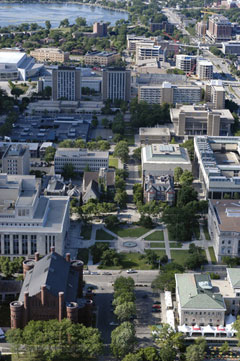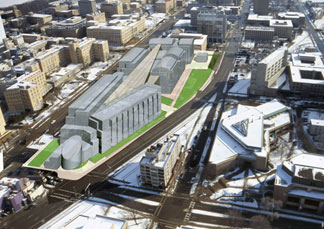2004-2005 Year in Review Continued
October 2004

East campus from the air
An East Campus Mall, first proposed in a 1908 campus master plan, is a main element of plans to revitalize the area with an arts–and–humanities district and new student housing. Plans include an expanded Elvehjem Museum, two new classroom buildings where the Humanities Building currently stands and a music performance facility east of the A.W. Peterson Office Building. Another project is a redeveloped University Square.
Arts Institute director Tino Balio announces his retirement after holding the post since the institute’s 1998 inception.
Daryl Buss, dean of the School of Veterinary Medicine, is named “Veterinarian of the Year” by the Wisconsin Veterinary Medical Association. The award is given annually to an association member who has made major contributions to the advancement of the veterinary medical profession.
The Medical School’s Center for Tobacco Research and Intervention receives a five–year, $8.5 million grant for research on tobacco dependence and its treatment. The research will study the long–term consequences of smoking and evaluate smoking–cessation treatments, with the hope that researchers will be able to eventually individualize tobacco–dependence treatments.
Faculty and instructional staff soon will use the My UW–Madison Web portal to submit student grades as part of a new e–Grading initiative. Registrar Joanne Berg says the method, which allows faculty to submit final grades from anywhere they have Web access, results in “an enormous improvement in service to students.”
November 2004
The Board of Regents approve construction of a $133.9 million Interdisciplinary Research Complex, which will replace outdated research facilities and unify the Medical School on the west campus. The first phase of the project will include a three–story base with a five–story tower adjacent to UW Hospital and Clinics, and will include laboratory facilities, offices, an imaging center and animal quarters. The project is the final phase of the 1997 Healthstar initiative, created to address the health care research and instructional needs of the 21st century.
Elton Aberle, dean of the College of Agricultural and Life Sciences since 1998, announces that he will retire in September 2005, capping a 38–year academic career that includes great success in attracting outside research funding for CALS. Federal funds awarded to the college more than doubled since 1998, from $30 million to $65 million annually.
Eighteen students in the Law School, under the guidance of professor Gordon Smith, set up a Web log to track developments in business law. The Web–based journal, employing a mix of commentary and news stories, allows aspiring lawyers to closely follow new legal wrinkles in a range of areas that interest them and to occasionally throw in their own two cents.
Adam Gamoran, professor of sociology and educational policy studies, is selected to be director of the Wisconsin Center for Education Research in the School of Education. His research interests include the sociology of education, organizational analysis and social stratification.
The College of Engineering’s master of engineering in professional practice is named the most outstanding online teaching and learning program by the Sloan Consortium, an association of more than 900 institutions and organizations of higher education engaged in online learning.
Gov. Jim Doyle announces that during the next several years, Wisconsin would invest up to $750 million in biomedical research, including more than $500 million in new facilities and direct research support for scientists at UW–Madison. The strategy is aimed at bolstering Wisconsin biotechnology, health sciences and stem cell research. Included in the plans is a $375 million public–private research institute, to be known as the Wisconsin Institute of Discovery. The institute would become an interdisciplinary research center combining biology, bioinformatics, computer science, engineering, nanotechnology and other fields in one setting. Also planned is a $134 million Interdisciplinary Research Complex near UW Hospital and Clinics and $1.5 million annually to support research on Alzheimer’s disease at UW–Madison.
Paul Barrows, vice chancellor for student affairs, steps down from his position and begins a personal leave. A relationship with a graduate student and Barrows’ use of sick leave spark an independent investigation, which Chancellor John D. Wiley and UW System President Kevin Reilly launch in late June 2005.
December 2004
The Board of Regents approve a $58.85 million project to redevelop University Square. University Health Services, a new Student Activities Center, and student services in the offices of the Registrar, Bursar and Student Financial Services will come together as part of the private–public partnership. Plans call for the majority of the project to include private parking, and retail and residential space in a major redevelopment replacing the single–story retail complex.
Medical School dean Philip Farrell announces that he will not seek reappointment after completing his current five–year term in December 2005. He also will leave his position as vice chancellor for medical affairs. The pediatric pulmonologist, who has served as dean for more than a decade, plans to concentrate on research, clinical practice and public health initiatives related to cystic fibrosis.
Continue to January–March 2005 »
